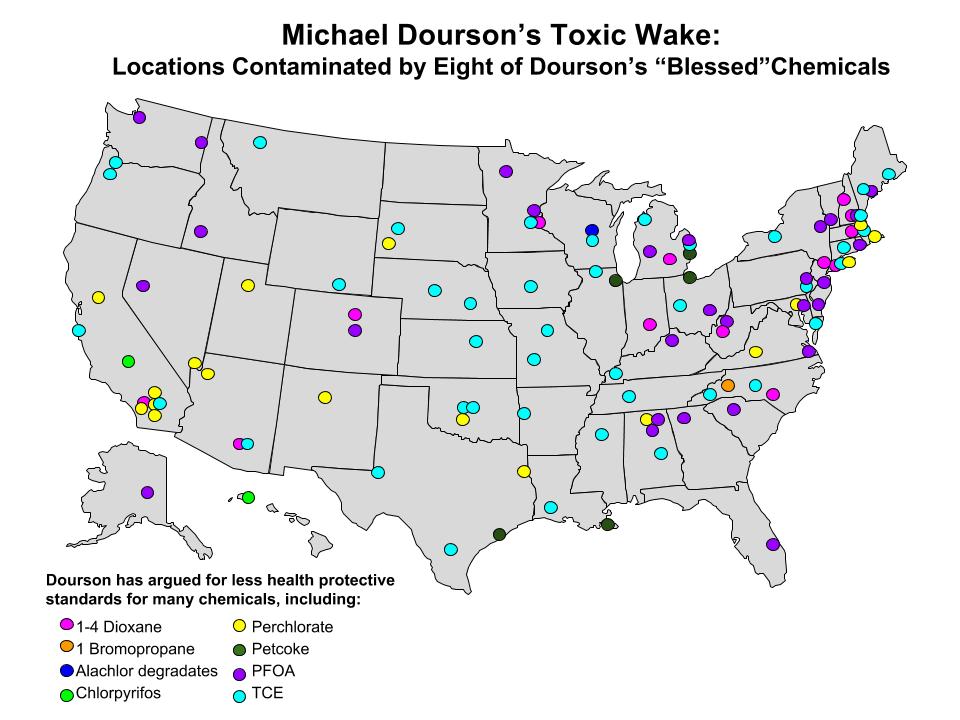Michael Dourson’s Toxic Wake: Locations Across the US Contaminated by Eight Chemicals “Blessed” by Trump EPA Toxics Nominee
Samantha Lovell is a Project Specialist.
[Update added November 17: On October 25, the Senate Committee on Environment and Public Works voted to advance Michael Dourson’s nomination to oversee chemical safety at the EPA. The fight is now in the full Senate, where two Republican senators have already come out against Dourson. With Democrats standing in strong opposition to this toxic nominee, Dourson’s nomination will not move forward if one more Republican senator comes out against him.]
[Use this link to see all of our posts on Dourson.]
In past blogs, we have documented deep concerns about Dourson’s extensive, longstanding ties to the chemical industry in addition to his earlier work for the tobacco industry. Dourson and his company Toxicology Excellence for Risk Assessment (TERA) were paid for their work by more than three dozen companies or trade associations, involving at least three dozen different chemicals.
Several recent news stories and reports have identified examples where Dourson or TERA helped industry play down health concerns about chemicals, including Dourson’s work in West Virginia involving the “Teflon” chemical PFOA and his study funded by Koch Industries in Chicago involving petroleum coke.
To illustrate the real-world impacts of his work, we have identified locations across the country where eight of the chemicals that Dourson has “blessed” have stirred concerns from residents about polluted water, soil, and air or poisoned residents and workers.
Using local and national news articles, and limiting our search to only eight of the many chemicals Dourson has been paid by industry to study, we identified 107 locations in 49 states. Each location is a place where a news story refers to one of the eight chemicals polluting the water, soil, or air or poisoning residents or workers in the area.
Our results – displayed in the map below – are by no means comprehensive, and represent only a fraction of locations affected by chemicals Dourson has worked on for industry clients. The map reveals that the entire country has experienced direct impacts from chemicals that Dourson has argued should have less health-protective standards.
While we didn’t identify a contamination location involving one of the eight chemicals in North Dakota, residents are still likely impacted by many of these chemicals. And, given Dourson’s work on chemicals like flame retardants that have pervaded every home in America, no one can escape the impacts of the chemicals Dourson has “blessed.”
For a full list of the news articles and chemical contamination locations by state, click here. In addition, Environmental Working Group (EWG) has posted interactive maps showing the extent of tap water contamination with 2 of these chemicals, 1-4 dioxane and PFOA, across the nation.
A few examples of the stories represented by the points on the map above include:
- 1,4-dioxane in southeastern Los Angeles County, California: Based on testing by the U.S. Geological Survey reported by EWG, southeastern LA County is one of the hot spots for 1,4-dioxane contamination in tap water across the country. Concentrations found in area water systems ranged from 4-14 times the EPA’s cancer risk level.
- 1-Bromopropane (1-BP) in North Carolina: From the 1990s through the 2000s, OSHA found employees at Royale Comfort Seating Plants in North Carolina were exposed to dangerous levels of 1-BP while working. As of 2011, the company had paid nearly a half-million dollars in court settlements and necessary upgrades.
- Alachlor degradates in Wisconsin groundwater: Statewide testing in Wisconsin revealed degradation products of alachlor –which is a widely used herbicide – across the state in groundwater and wells. The “ESA” degradate of alachlor was the second most commonly detected pesticide in the wells tested.
- Chlorpyrifos in Kauai, Hawaii: EPA filed a complaint with the pesticide producer, Syngenta, in 2016 following a pesticide poisoning on a farm in Kauai. Several farmworkers were hospitalized after dangerous exposure to chlorpyrifos.
- Perchlorate in the Southwest: In 1997, EPA discovered high perchlorate levels in the lower Colorado River and Lake Mead, which provides drinking water to millions in the region. The contamination came from two perchlorate manufacturing facilities in the area, and efforts to clean up the tainted surface water and groundwater are ongoing.
- Perfluorooctanoic acid (PFOA) in Hoosick Falls, NY: High levels of PFOA were discovered in the Hoosick Falls community’s groundwater, originating from the Saint-Gobain Performance Plastics facility. In 2017, EPA added the location to the Federal Superfund List.
- Petroleum coke (Petcoke) in Plaquemines Parish area, Louisiana: United Bulk, a coal export facility, was sued in 2014 for discharging coal and petcoke from its facility in Plaquemines Parish into the Mississippi River. The lawsuit was settled in 2015.
- Petcoke in Chicago, Illinois: In 2013, Chicago residents reported concern over windblown dust from piles of petcoke owned by KCBX terminals – a Koch subsidiary – on the city’s Southeast side. One of the facilities has since closed and the other no longer stores petcoke in the open.
- Trichloroethylene (TCE) in the Cheyenne area, Wyoming: TCE was found in the groundwater around several of the Atlas Missile sites – used during the Cold War to hold and prepare nuclear missiles – in the early 2000s. A plume from one site had concentrations of TCE approximately 48,000 times the legal limit.
Communities affected by Dourson “blessed” chemicals should urge their Senators to oppose Dourson’s appointment.
We need strong leadership in the EPA toxics office to ensure successful implementation of the newly reformed TSCA and to protect the health of all Americans from toxic chemicals and pesticides.
Otherwise, with Michael Dourson in charge, we’ll just see an even bigger toxic wake.
Current EPA political appointees already include a number of industry insiders.
Click here to see brief thumbnails on individuals who have already been installed.













